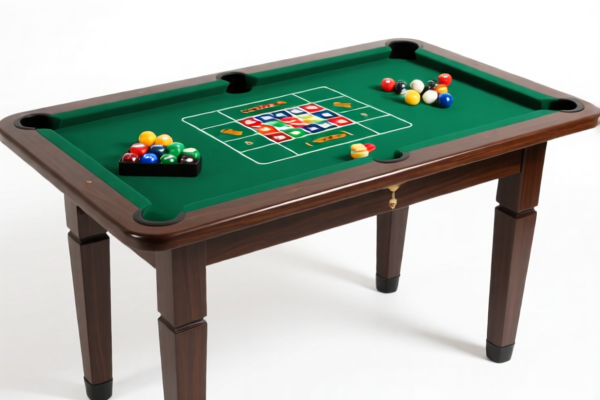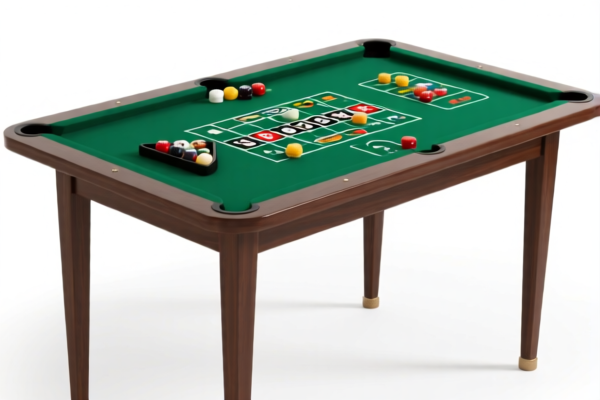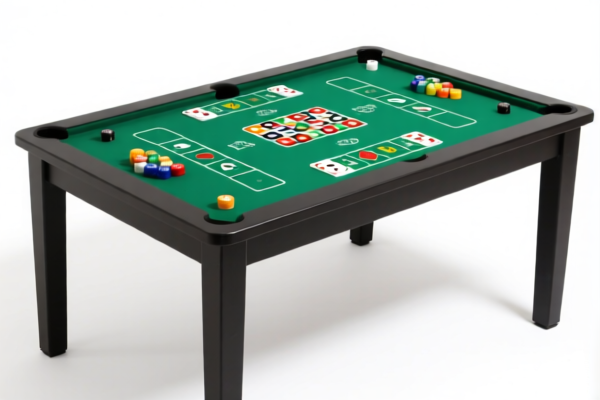| HS Code | Official Doc | Tariff Rate | Origin | Destination | Effective Date |
|---|---|---|---|---|---|
| 9504206000 | Doc | 30.0% | CN | US | 2025-05-12 |
| 9504904000 | Doc | 30.0% | CN | US | 2025-05-12 |
| 4701000000 | Doc | 55.0% | CN | US | 2025-05-12 |
| 4823901000 | Doc | 55.0% | CN | US | 2025-05-12 |
| 4823902000 | Doc | 55.0% | CN | US | 2025-05-12 |
| 4911998000 | Doc | 37.5% | CN | US | 2025-05-12 |
| 4911996000 | Doc | 37.5% | CN | US | 2025-05-12 |
| 4901990070 | Doc | 37.5% | CN | US | 2025-05-12 |
| 4901990093 | Doc | 37.5% | CN | US | 2025-05-12 |
| 3924104000 | Doc | 33.4% | CN | US | 2025-05-12 |
| 3924905650 | Doc | 40.9% | CN | US | 2025-05-12 |




Table Games
Table games are games typically played on a flat surface, such as a table, involving components like boards, cards, dice, and tokens. They encompass a broad range of styles, often emphasizing strategy, skill, chance, or a combination of these elements.
Materials
Common materials used in table games include:
- Cardboard/Paperboard: Used for game boards, cards, tiles, and packaging.
- Plastic: Frequently used for game pieces, tokens, dice, and card sleeves.
- Wood: Employed for higher-quality game boards, pieces, and storage boxes.
- Metal: Can be found in tokens, miniatures, or decorative elements.
- Dice: Typically made of plastic, resin, or wood, used to introduce randomness.
- Cards: Constructed from coated card stock, often with linen or plastic finishes for durability.
- Tokens/Markers: Made from plastic, wood, or metal, used for tracking score, resources, or player positions.
Purpose
The primary purpose of table games is entertainment, fostering social interaction and cognitive engagement. Beyond recreation, they can:
- Develop Strategic Thinking: Many games require planning, analysis, and decision-making.
- Enhance Problem-Solving Skills: Players often encounter challenges that require creative solutions.
- Promote Social Skills: Games encourage communication, negotiation, and teamwork.
- Stimulate Cognitive Function: Some games improve memory, attention, and spatial reasoning.
Function
Table games function through a set of rules that govern player actions and determine the game's outcome. Key functional elements include:
- Turn-Based Play: Players typically take actions in a defined sequence.
- Rule Sets: Provide the framework for gameplay, including movement, resource management, and interaction.
- Winning Conditions: Define the criteria for achieving victory.
- Randomness: Often incorporated through dice rolls, card draws, or other mechanisms to create unpredictability.
- Player Interaction: Games can involve cooperation, competition, or both.
Usage Scenarios
Table games are suitable for a variety of settings:
- Family Game Nights: Providing a shared activity for families.
- Social Gatherings: Offering entertainment for friends and groups.
- Educational Settings: Used to teach concepts and develop skills.
- Game Conventions/Events: A focal point for enthusiasts and competitions.
- Individual Play (Solitaire): Some games are designed for single-player experiences.
Common Types
Table games are broadly categorized into several types:
- Abstract Strategy Games: (e.g., Chess, Go, Checkers) Focus on pure strategy with no narrative theme.
- Eurogames: (e.g., Settlers of Catan, Ticket to Ride, Carcassonne) Emphasize resource management, engine-building, and limited direct conflict.
- Ameritrash Games: (e.g., Risk, Monopoly, Talisman) Feature thematic elements, player interaction, and often involve luck and conflict.
- Cooperative Games: (e.g., Pandemic, Gloomhaven) Players work together towards a common goal.
- Party Games: (e.g., Codenames, Dixit, Cards Against Humanity) Designed for larger groups, emphasizing social interaction and humor.
- War Games: (e.g., Axis & Allies, Memoir '44) Simulate military conflicts with detailed rules and strategic depth.
- Role-Playing Games (RPGs): (e.g., Dungeons & Dragons) Players assume roles and collaborate to create a narrative. Often use table games mechanics.
- Collectible Card Games (CCGs): (e.g., Magic: The Gathering, Pokémon TCG) Players build decks and compete against each other.
- Legacy Games: (e.g., Pandemic Legacy, Gloomhaven: Jaws of the Lion) Games that change permanently as players progress, with evolving rules and components.
Table games encompass a variety of recreational and amusement devices. Based on the provided information, several HS codes may be relevant:
- 9504206000: This HS code covers video game consoles and machines, table or parlor games, including pinball machines, billiards, special tables for casino games and automatic bowling equipment, amusement machines operated by coins, banknotes, bank cards, tokens or by any other means of payment. Specifically, it includes articles and accessories for billiards of all kinds and tables. The total tax rate is 30.0%, comprising a base tariff of 0.0% and an additional tariff of 30.0% effective April 2, 2025.
- 9504904000: This HS code also falls under the category of video game consoles and machines, table or parlor games, including pinball machines, billiards, special tables for casino games and automatic bowling equipment, amusement machines operated by coins, banknotes, bank cards, tokens or by any other means of payment. However, it specifically covers other game machines other than those operated by coins, banknotes (paper currency), discs or similar articles; and parts and accessories thereof. The total tax rate is 30.0%, with a base tariff of 0.0% and an additional tariff of 30.0% effective April 2, 2025.
It is important to determine whether the table games are operated by coins, banknotes, or other means of payment to correctly classify them under either 9504206000 or 9504904000.
Customer Reviews
I really appreciated the straightforward info on HS code 3925 and the tariff rates. This helped me with my export paperwork.
This page was super useful for understanding HS Code 3925. I'm exporting plastic doors and this made everything much clearer.
The information on the 5% tariff rate is spot-on. I was able to calculate my costs accurately for the shipment.
The details on the 5% import duty for the US were helpful, but I wish there were more countries covered as well.
Very clear explanation of the HS code and tariff rates for plastic doors. Perfect for someone new to international trade.